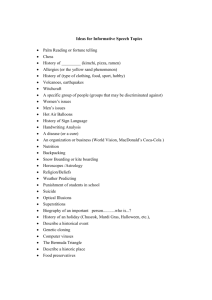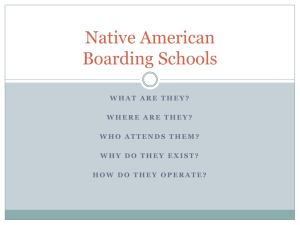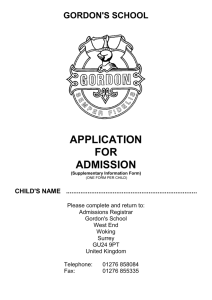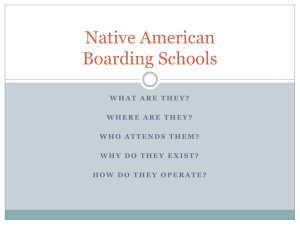Document
advertisement
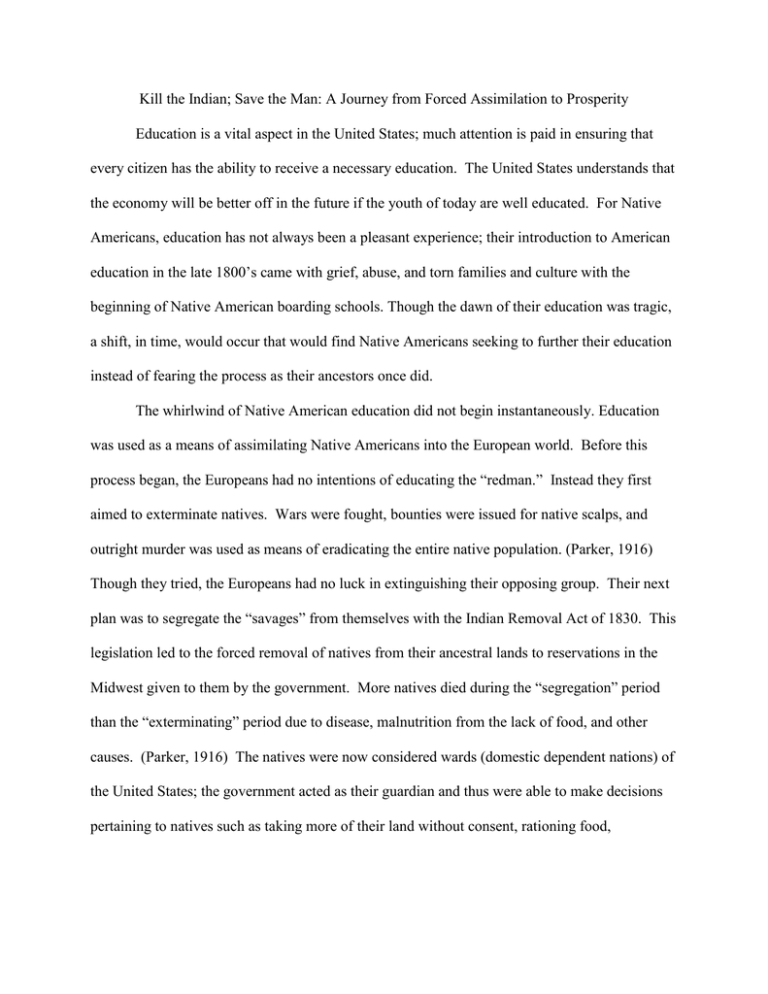
Kill the Indian; Save the Man: A Journey from Forced Assimilation to Prosperity Education is a vital aspect in the United States; much attention is paid in ensuring that every citizen has the ability to receive a necessary education. The United States understands that the economy will be better off in the future if the youth of today are well educated. For Native Americans, education has not always been a pleasant experience; their introduction to American education in the late 1800’s came with grief, abuse, and torn families and culture with the beginning of Native American boarding schools. Though the dawn of their education was tragic, a shift, in time, would occur that would find Native Americans seeking to further their education instead of fearing the process as their ancestors once did. The whirlwind of Native American education did not begin instantaneously. Education was used as a means of assimilating Native Americans into the European world. Before this process began, the Europeans had no intentions of educating the “redman.” Instead they first aimed to exterminate natives. Wars were fought, bounties were issued for native scalps, and outright murder was used as means of eradicating the entire native population. (Parker, 1916) Though they tried, the Europeans had no luck in extinguishing their opposing group. Their next plan was to segregate the “savages” from themselves with the Indian Removal Act of 1830. This legislation led to the forced removal of natives from their ancestral lands to reservations in the Midwest given to them by the government. More natives died during the “segregation” period than the “exterminating” period due to disease, malnutrition from the lack of food, and other causes. (Parker, 1916) The natives were now considered wards (domestic dependent nations) of the United States; the government acted as their guardian and thus were able to make decisions pertaining to natives such as taking more of their land without consent, rationing food, distributing clothes, etc. (Harvard, 1912) Though they were wards, they were still not looked upon as citizens of the United States. It was during the “segregation” period that education began to appear on Native American reservation through the work of missionaries. Christian and Catholic missionaries (without governmental aid) began to open day schools on reservations as a means of assimilating and converting the natives. The curriculum consisted of basic literacy, math, English, and religion courses. The government began to fund the schools after seeing the beginning signs of success with a large portion of the native children now speaking English and becoming a part of their new culture. At the time, adults on the reservations were not opposed to the schools due to the fact that attendance was optional, inexpensive, and the children thrived. However, government officials soon found the schools insufficient in the way of assimilation due to the fact that tribal influences were still present in the lives of the children. In order to truly remove native culture from the children, the schools must be removed from tribal influences and off of the reservation. (NRCPrograms, 2015) This process was put into effect with the passage of the Dawes Act of 1887. This legislation carried two parts. First, tribal pull within the reservations was eliminated by the governmental dividing of land. Each family was allotted a certain number of acres of land to sustain themselves. Those who cooperated were able to become citizens of the United States. Secondly, parents were now required to send their children to off reservation boarding schools. By sending the children away from their families and tribes, the process of assimilation is simplified. If the parents refused, authorities were sent to retrieve the children in order to deliver them to the boarding schools. (Bickford-Duane, 2015) The first off reservation school was the Carlisle Indian Industrial School located in Carlisle, Pennsylvania. The school was founded by Lieutenant R H. Pratt of the Army. Pratt was also the man behind the idea of Native American boarding schools. In 1875, Pratt transported 74 native prisoners of war to Fort Marian in St. Augustine, Florida where they were to be held for three years. The “prisoners” were taught military regimes and put to work. The natives were trusted with working within the nearby community by means of farming, construction, and laboring in sawmills. Soon the women of St. Augustine began teaching the natives basic academics and religious studies. When the three years were up, the natives wished to remain at the fort to further their learning. It was then that Pratt had an epiphany; it is in fact possible to civilize the natives through discipline, labor, and education. He then coined his motto, “Kill the Indian; save the man.” He now knew the formula needed to assimilate the redmen, thus leading to the founding of the Carlisle School; a school whose goal was to eradicate (kill) the Indian part of the students and covert them to civilized men and women. (Sparthawk, 1906) Figure 1 Richard Henry Pratt During its first year, the Carlisle School enrolled 147 students from various tribes such as the Sioux, Cherokee, Lakota, and Apache. (Eastman, 1914) Soon Carlisle would average 1,200 students a year. Many parents willingly sent their children knowing that education was the only way for them to have a chance of living a better life. The minimum age required for attendance at Carlisle was 14 and the term was for 5 years. Other boarding schools admitted children as young as four and incorporated a primary and college prep term. (Eastman) Upon arrival at the school, children were stripped of their native clothing and assigned European school uniforms. Each student would then have their long hair and braids cut off in order to further conform them into the European culture. This act caused much grief to the young native children due to the significance of their long hair. Long hair in the Native American religion is very symbolic; it is not ever to be cut unless in a time of immense mourning. (McKenzie, 1914) In all likelihood, this was the first haircut that these children had experienced. This caused the children to emotionally withdraw even more. The children were then given English names as the final act of disposing of any evidence of their native identity. (Sparthawk) Figure 2 Top - Students upon arrival at Carlisle Indian School. Bottom same students three months later The typical school day consisted of academic classes for half of the day and industrial classes for the second half. The students took general academic classes including English, math, history, and religion. The industrial classes included blacksmithing, shoemaking, carpentry, mechanical work, and manual labor for the boys and cooking, sewing, cleaning, and small farm work for the girls. The children were able to put their industrial skills to work due to the fact that the institution used their labor to remain self-sufficient. For example, the boys would perform the manual labor on campus which could include running a small farm that the campus owned while the girls would be responsible for cleaning and doing the laundry of the entire institution. (Slivka, 2011) As the children matured in their studies, some were sent into the community during the school year and summer to perform labor and expand on their education. Although the main purpose of doing so was to progress their education of European culture within the community, the students were often exploited for their labor. Their time spent working outweighed the time spent learning. (Sparthawk) The Carlisle School, along with the other boarding schools, were ran with discipline as their driving force. Strict rules were put in place to prohibit students from practicing their native culture such as speaking their language, practicing traditions, and following tribal religions. Severe corporal punishment was used as a means of punishing those found acting out any aspect of native culture. (Bickford-Duane) Many of the children in these boarding schools experienced harsh physical abuse during the beginning of the boarding school era. The Europeans used many different forms of punishment on the children in order to wipe out native culture including confinement, removal of privileges, the threat of physical abuse, and the restriction of diet. Many children were harmed enough to the point where their experience at boarding school scarred them for life; the very thing that was meant to enhance their life instead ruined it. (Eastman) The students were prohibited from going home during their stay at boarding school. Because of this and the abuse, it was common for students to run away from their schools. The majority of the students were hundreds, sometimes thousands of miles away from their families. Even if a child’s family lived near the school, they could not withdraw their child from school because of government laws. Parents finally gained the rights to deny and withdraw their child from boarding schools with the passage of the Indian Child Welfare Act of 1978. (NRCPrograms) The boarding schools were also a breeding ground for illness and disease for the children. By taking the children out of their natural environment, their bodies were not accustomed and immune to the illnesses of their new home. Tuberculosis and Trachoma (sore eyes) were the biggest threats to students. In December of 1899, a large outbreak of measles occurred at the Phoenix Indian School. Within 10 days there were 325 cases of measles, 60 cases of pneumonia, and 9 deaths. (NRCPrograms) It was common for children to pass away of illnesses at boarding schools; in fact, every Native American boarding school possessed their own cemetery for such occasions. If a child died, their body was not sent home for burial but instead buried at the school. Sometimes parents would not be notified of their child’s passing until after burial. (NRCPrograms) Figure 3 Carlisle Indian School cemetery All Native American boarding schools followed a similar model to that of the Carlisle Indian School. Though the beginning of the boarding schools had a dark shadow cast upon it due to the terrible conditions including abuse and emotional distress, a shift began to occur within the schools. Abuse within the schools had decreased significantly as new generations of children attended the schools. By this time around the 1940’s, many of the children arriving at the schools already spoke English and were at the least vaguely familiar with European culture. This made the transition smoother for the children; it was less of a culture shock compared to the experiences of their predecessors. In fact, many of the alumni of the boarding schools returned to educate the younger fellow Native Americans. This changed the mindset from “Kill the Indian, save the man” to sole education for the children. More parents began to willingly send their children to the schools and education became a key value for Native Americans to strive to hold and receive. (Slivka) It was evident that the schools benefited the children later in life. For example, 565 graduates of the Carlisle School were polled two decades after graduation and 496 were employed, 110 were employed in government agencies, and only 69 were unemployed at the time but had been employed in the past. (Eastman) The information researched above is very personal to me due to the fact that I am a Native American and a proud member of the Chickahominy Tribe. I’ve heard countless stories from grandparents, family members, and elders of the tribe detailing their personal experiences with education. The elders of the tribe experienced immense hardships in their journey to receive a valuable education and many ventured to boarding schools along their journey. The Chickahominy Tribe does not reside on a reservation. Because of this, our tribal members were not mandated to attend the boarding schools. Instead, our only option was to open our own school for the children; the native children were forbidden from attending the white and colored schools in our county. The tribe opened the Samaria Indian School around 1920 which operated in the Samaria Indian Baptist Church building. The school served the Chickahominy children as well as some children from the Mattoponi and Pamunkey Tribes. In its beginning, the tribe funded the salaries for all teachers and staff themselves. They were also self-sufficient on account of they supplied their own school buses for the children. A gentleman of the tribe bought two school buses for the school to use because children were having to walk five to ten miles every day to go to school. Figure 5 Group photo of students on the steps of the Samaria India School Figure 4 Samaria Indian Church 1910 For the first few decades, the school only extended to the 8th grade and could not legally distribute high school diplomas. The only other educational option for students wanting to graduate high school was to attend a boarding school. The majority of the Chickahominy students who chose to do so chose to attend Bacone College in Oklahoma, a Native American boarding school offering junior college (high school) and a college education. Those who chose not to attend boarding school typically went to work on family farms until they were old enough to be employed. The State of Virginia paid a subsidy of $200 to each student who attended Bacone until 1950. (Charles City) Figure 6 Bacone Class of 1950 including 6 members of the Chickahominy Tribe Many of my aunts and uncles attended Bacone as adolescents. I’ve spoken to one uncle in particular numerous times about his experiences at Bacone. He left home as a teenager to attend Bacone after completing part of his education at the Samaria Indian School. His initial year at Bacone was difficult for him because of homesickness; it was very difficult being so far away from his family as a young man. He was not able to travel home often because of the distance and cost of travel. During his stay at Bacone, his time was occupied with both school and work. As stated earlier, many boarding schools relied heavily on student labor to be selfsufficient. His duties sometimes included cleaning the dining area, landscaping, and cleaning the boys’ area. His stay at boarding school was after the reports of abuse at such institutions had ceased. Students were never intentionally physically, mentally, or sexually abused as means of aiding in the education process. However, some of the teachers and staff were very strict on the students. “They would not tolerate a lot of nonsense,” my uncle stated. Though physical abuse was not used, students would still experience corporal punishment if they routinely misbehaved. The punishment was only used for correcting behavior. He never feared for his personal safety while at Bacone; he saw it as a safe environment where he knew that he would receive the best education possible for him. Overall, my uncle’s experience at a boarding school was productive, engaging, and a great experience. Along with attending Bacone, students also had the option of attending Oak Hill Academy in Mouth of Wilson, Virginia. Oak Hill is a Baptist affiliated boarding school that caters to individuals from every race and ethnic background, not just Native Americans. The school averages under 200 students in grades 8-12. Oak Hill was not a first choice school for Chickahominy students because Bacone was of higher prestige in their academics and public reputation. Even so, a handful of Chickahominy students chose to attend Oak Hill Academy to finish their schooling. One of the individuals who chose to attend Oak Hill was respected Chickahominy elder Melvin Stewart. I was granted the pleasure to interview Mr. Melvin about his experience at Oak Hill. Just like the other Chickahominy children, Mr. Melvin completed school at the Samaria Indian School which at the time offered schooling up to the 10th grade. At the time, no other Chickahominy student had yet to attend Oak Hill. Despite this, Mr. Melvin and fellow classmate Derwood Jefferson made the decision to attend Oak Hill. When asked why he chose to attend the small and less prestigious Oak Hill Academy instead of Bacone he stated, “I didn’t want to go far away from home! It was more convenient; I could get there in a couple hours with the school being on the North Carolina-Virginia line.” When Mr. Melvin enrolled at Oak Hill, he had intentions of being there for two years but he was soon informed that he had enough credits to allow him to graduate in one year instead of two. Mr. Melvin’s experiences at Oak Hill were similar to those of my uncle at Bacone. The school owned a dairy farm where students would work on occasions when not in class. However, the dairy farm was no longer in use at the time when Mr. Melvin was at the institution. With the school being affiliated with the Baptist church, it was required that the students attend weekly services. The chapel that the students attended was a mile off campus. Mr. Melvin can recall of many occasions when late students would have to sprint to the chapel in order to get there in time! He also went on to say that Oak Hill was not like other boarding schools where students were abused. “It was not that kind of school,” he stated. “They were very strict with us though and would use the paddle on us at times but it was never anything excessive.” Overall, Mr. Melvin’s experience at Oak Hill Academy was “average,” like that of any school. “It was a normal school,” he stated. They took the students on trips to the theater to view plays, the students participated in sports such as baseball and basketball, and he was able to journey home to visit his family. He enjoyed his time there. These are only a few examples of the students who chose to attend boarding schools in order to further/finish their education. The Samaria Indian School did not offer all 12 grades of schooling until near 1960. Students continued to attend Samaria until the local schools, Charles City County Public Schools, integrated in 1971. (Jones, 2014) Looking back at the whirlwind history of Native American education makes me appreciate the education that I am able to receive today. I am free to attend any school of my choosing and to pursue any avenue of vocation and education unlike my ancestors. Many of the children’s experiences were filled with pain and suffering during their forced years of education. Their very identity was stripped from them in an attempt to absorb them into the European lifestyle and culture. Innocent lives were lost and taken in the process of “Killing the Indian and saving the man.” The tactics would soon change as the benefits of receiving an education began to come to light amongst the sorrows of the failures of the schools. Parents, children, and tribes accepted the idea of education after viewing that the lives of the children who had received an education were more fruitful, rewarding, and promising compared to those who did not. Native Americans were finally thriving in life. What once began as an attempt to conformity has now lead to the freedom of Native American youth to become whoever they want to be. However, this is just the beginning; the history of Native American education is not over. The up and coming native scholars of today will set the standards for the generations to come. It is my vow to aid in this process in any way that I can. We shall rise from the ashes once again. References Bickford-Duane, P. (2015). DESTROYING a Culture. Cobblestone, 36(1), 17 Chickahominy Gallery: Church & School. (n.d.). Retrieved November 9, 2015, from http://www.charlescity.org/natives/topic-churchschool.php EASTMAN, C. A.. (1914). THE INDIAN IN SCHOOL. The Journal of Education, 80(24 (2010)), 653–654. Retrieved from http://www.jstor.org/stable/42768165 Indians and the United States. (1912). Indians and the United States. Harvard Law Review, 25(8), 733–734. http://doi.org/10.2307/1324030 Jones, A. (2014, March 5). CC schools honor historian, marchers for Black History month -. Retrieved November 9, 2015, from http://nkccnews.com/local-news/2014/03/05/ccschools-honor-historian-marchers-black-history-month/ McKenzie, F. A.. (1914). The Assimilation of the American Indian. American Journal of Sociology, 19(6), 761–772. Retrieved from http://www.jstor.org/stable/2763215 Native American History and Culture: Boarding Schools - American Indian Relief Council. (n.d.). Retrieved November 9, 2015, from http://www.nrcprograms.org/site/PageServer?pagename=airc_hist_boardingschools Parker, A. C.. (1916). The Social Elements of the Indian Problem. American Journal of Sociology, 22(2), 252–267. Retrieved from http://www.jstor.org/stable/2763824 SLIVKA, K. (2011). Art, Craft, and Assimilation: Curriculum for Native Students during the Boarding School Era. Studies In Art Education, 52(3), 225-242. Sparhawk, F. C.. (1906). The Indian's Yoke. The North American Review, 182(590), 50–61. Retrieved from http://www.jstor.org/stable/25105509 Amanda Holmes Honors Introduction to Anthropology Dr. Jordon
